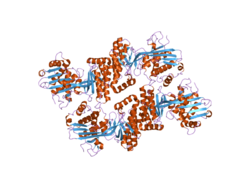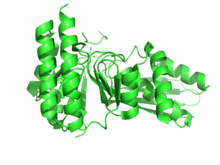メバロン酸キナーゼ
表示
| MVK | |||||||||||||||||||||||||
|---|---|---|---|---|---|---|---|---|---|---|---|---|---|---|---|---|---|---|---|---|---|---|---|---|---|
 | |||||||||||||||||||||||||
| |||||||||||||||||||||||||
| 識別子 | |||||||||||||||||||||||||
| 記号 | MVK, LRBP, MK, MVLK, POROK3, mevalonate kinase | ||||||||||||||||||||||||
| 外部ID | OMIM: 251170、260920、610377、175900 MGI: 107624 HomoloGene: 372 GeneCards: MVK | ||||||||||||||||||||||||
| |||||||||||||||||||||||||
| |||||||||||||||||||||||||
| |||||||||||||||||||||||||
| オルソログ | |||||||||||||||||||||||||
| 種 | ヒト | マウス | |||||||||||||||||||||||
| Entrez | |||||||||||||||||||||||||
| Ensembl | |||||||||||||||||||||||||
| UniProt | |||||||||||||||||||||||||
| RefSeq (mRNA) | |||||||||||||||||||||||||
| RefSeq (タンパク質) | |||||||||||||||||||||||||
| 場所 (UCSC) | Chr 12: 109.57 – 109.6 Mb | Chr 12: 114.58 – 114.6 Mb | |||||||||||||||||||||||
| PubMed検索 | [4] | [5] | |||||||||||||||||||||||
| ウィキデータ | |||||||||||||||||||||||||
| |||||||||||||||||||||||||
メバロン酸キナーゼ(Mevalonate kinase)は、イソプレノイド生合成経路の一つであるメバロン酸経路の4番目の酵素である。ヒトにおいてMVK遺伝子でコードされる[6][7]。細菌から哺乳類まで幅広い生物で見られる。この酵素は、以下の化学反応を触媒する。

機能
[編集]メバロン酸は、イソプレノイド及びステロールの生合成において鍵となる中間体であり、メバロン酸キナーゼは初期段階の鍵となる酵素である[6]。メバロン酸をリン酸化して、5-ホスホメバロン酸を産生する[8]。メバロン酸キナーゼ活性の5–10%の低下はメバロン酸キナーゼ欠損症と関係しており、メバロン酸経路の中間体であるメバロン酸が蓄積する[9]。
メバロン酸キナーゼはメバロン酸経路の5番目および6番目の酵素とはアミノ酸配列が相同であり、いずれも共通祖先から分岐したと考えられる(GHMPファミリー)。
 |
臨床上の重要性
[編集]この酵素の異常は、発熱を繰り返す高IgD症候群と関連がある[10]。
メバロン酸キナーゼ欠損症はこの遺伝子の変異によって生じ、精神運動発達遅滞、発育不良、肝脾腫、貧血、再発性の発熱などで特徴づけられる、メバロン酸尿症を引き起こす。また、この遺伝子の欠損は周期性発熱を伴う高IgD症候群を引き起こし、この疾患はリンパ節腫脹、関節痛、胃腸の異常、皮膚の発疹を伴う再発性の発熱によって特徴づけられる[6]。疾患の症状は典型的には幼児期から始まり、ストレスや細菌感染によってさらに活発になる。メバロン酸キナーゼ欠損症を正確に診断するための十分な科学的データが現時点ではないため、長い間診断がなされていない状態となっている可能性がある[9]。
出典
[編集]- ^ PDB: 2X7I; Oke M, Carter LG, Johnson KA, Liu H, McMahon SA, Yan X, Kerou M, Weikart ND, Kadi N, Sheikh MA, Schmelz S, Dorward M, Zawadzki M, Cozens C, Falconer H, Powers H, Overton IM, van Niekerk CA, Peng X, Patel P, Garrett RA, Prangishvili D, Botting CH, Coote PJ, Dryden DT, Barton GJ, Schwarz-Linek U, Challis GL, Taylor GL, White MF, Naismith JH (June 2010). “The Scottish Structural Proteomics Facility: targets, methods and outputs”. J. Struct. Funct. Genomics 11 (2): 167-80. doi:10.1007/s10969-010-9090-y. PMC 2883930. PMID 20419351.
- ^ a b c GRCh38: Ensembl release 89: ENSG00000110921 - Ensembl, May 2017
- ^ a b c GRCm38: Ensembl release 89: ENSMUSG00000041939 - Ensembl, May 2017
- ^ Human PubMed Reference:
- ^ Mouse PubMed Reference:
- ^ a b c “Entrez Gene: mevalonate kinase”. 2015年1月26日閲覧。
- ^ Schafer BL, Bishop RW, Kratunis VJ, Kalinowski SS, Mosley ST, Gibson KM, Tanaka RD (July 1992). “Molecular cloning of human mevalonate kinase and identification of a missense mutation in the genetic disease mevalonic aciduria”. J. Biol. Chem. 267 (19): 13229-38. PMID 1377680.
- ^ Mulders-Manders, C. M.; Simon, A. (2015-07). “Hyper-IgD syndrome/mevalonate kinase deficiency: what is new?”. Seminars in Immunopathology 37 (4): 371–376. doi:10.1007/s00281-015-0492-6. ISSN 1863-2300. PMC 4491100. PMID 25990874.
- ^ a b Stabile, Achille; Compagnone, Adele; Napodano, Salvatore; Raffaele, Carmela Gerarda Luana; Patti, Maria; Rigante, Donato (2013-12). “Mevalonate kinase genotype in children with recurrent fevers and high serum IgD level”. Rheumatology International 33 (12): 3039–3042. doi:10.1007/s00296-012-2577-z. ISSN 1437-160X. PMID 23239036.
- ^ Online 'Mendelian Inheritance in Man' (OMIM) 260920
関連文献
[編集]- Ma J, Dempsey AA, Stamatiou D, et al. (2007). “Identifying leukocyte gene expression patterns associated with plasma lipid levels in human subjects.”. Atherosclerosis 191 (1): 63-72. doi:10.1016/j.atherosclerosis.2006.05.032. PMID 16806233.
- Willer CJ, Sanna S, Jackson AU, et al. (2008). “Newly identified loci that influence lipid concentrations and risk of coronary artery disease.”. Nat. Genet. 40 (2): 161-9. doi:10.1038/ng.76. PMID 18193043.
- Naruto T, Nakagishi Y, Mori M, et al. (2009). “Hyper-IgD syndrome with novel mutation in a Japanese girl.”. Mod Rheumatol 19 (1): 96-9. doi:10.1007/s10165-008-0130-4. PMID 18941711.
- Krisans SK (1992). “The role of peroxisomes in cholesterol metabolism.”. Am. J. Respir. Cell Mol. Biol. 7 (4): 358-64. doi:10.1165/ajrcmb/7.4.358. PMID 1356376.
- Houten SM, Wanders RJ, Waterham HR (2000). “Biochemical and genetic aspects of mevalonate kinase and its deficiency.”. Biochim. Biophys. Acta 1529 (1-3): 19-32. doi:10.1016/s1388-1981(00)00135-9. PMID 11111075.
- Fu Z, Voynova NE, Herdendorf TJ, et al. (2008). “Biochemical and structural basis for feedback inhibition of mevalonate kinase and isoprenoid metabolism.”. Biochemistry 47 (12): 3715-24. doi:10.1021/bi7024386. PMID 18302342.
- Kathiresan S, Willer CJ, Peloso GM, et al. (2009). “Common variants at 30 loci contribute to polygenic dyslipidemia.”. Nat. Genet. 41 (1): 56-65. doi:10.1038/ng.291. PMC 2881676. PMID 19060906.
- Hager EJ, Gibson KM (2007). “Mevalonate kinase deficiency and autoinflammation.”. N. Engl. J. Med. 357 (18): 1871-2. doi:10.1056/NEJMc072799. PMID 17978300.
- Marques-Vidal P, Bochud M, Paccaud F, et al. (2010). “No interaction between alcohol consumption and HDL-related genes on HDL cholesterol levels.”. Atherosclerosis 211 (2): 551-7. doi:10.1016/j.atherosclerosis.2010.04.001. PMID 20430392.
- Lu Y, DollAc ME, Imholz S, et al. (2008). “Multiple genetic variants along candidate pathways influence plasma high-density lipoprotein cholesterol concentrations.”. J. Lipid Res. 49 (12): 2582-9. doi:10.1194/jlr.M800232-JLR200. PMID 18660489.
- Samkari A, Borzutzky A, Fermo E, et al. (2010). “A novel missense mutation in MVK associated with MK deficiency and dyserythropoietic anemia.”. Pediatrics 125 (4): e964-8. doi:10.1542/peds.2009-1774. PMID 20194276.
- Nakayama K, Bayasgalan T, Yamanaka K, et al. (2009). “Large scale replication analysis of loci associated with lipid concentrations in a Japanese population.”. J. Med. Genet. 46 (6): 370-4. doi:10.1136/jmg.2008.064063. PMID 19487539.
- KonAc-Paut I, Sanchez E, Le Quellec A, et al. (2007). “Autoinflammatory gene mutations in BehA§et's disease.”. Ann. Rheum. Dis. 66 (6): 832-4. doi:10.1136/ard.2006.068841. PMC 1954666. PMID 17213252.
- Weissglas-Volkov D, Aguilar-Salinas CA, Sinsheimer JS, et al. (2010). “Investigation of variants identified in caucasian genome-wide association studies for plasma high-density lipoprotein cholesterol and triglycerides levels in Mexican dyslipidemic study samples.”. Circ Cardiovasc Genet 3 (1): 31-8. doi:10.1161/CIRCGENETICS.109.908004. PMC 2827864. PMID 20160193.
- Simon A, van der Meer JW, Vesely R, et al. (2006). “Approach to genetic analysis in the diagnosis of hereditary autoinflammatory syndromes.”. Rheumatology (Oxford) 45 (3): 269-73. doi:10.1093/rheumatology/kei138. PMID 16234278.
- Gattorno M, Sormani MP, D'Osualdo A, et al. (2008). “A diagnostic score for molecular analysis of hereditary autoinflammatory syndromes with periodic fever in children.”. Arthritis Rheum. 58 (6): 1823-32. doi:10.1002/art.23474. PMID 18512793.
- Fogarty MP, Xiao R, Prokunina-Olsson L, et al. (2010). “Allelic expression imbalance at high-density lipoprotein cholesterol locus MMAB-MVK.”. Hum. Mol. Genet. 19 (10): 1921-9. doi:10.1093/hmg/ddq067. PMC 2860891. PMID 20159775.
- Nair AK, Young MA, Menon KM (2008). “Regulation of luteinizing hormone receptor mRNA expression by mevalonate kinase--role of the catalytic center in mRNA recognition.”. FEBS J. 275 (13): 3397-407. doi:10.1111/j.1742-4658.2008.06490.x. PMID 18494797.
- Deo RC, Reich D, Tandon A, et al. (2009). “Genetic differences between the determinants of lipid profile phenotypes in African and European Americans: the Jackson Heart Study.”. PLoS Genet. 5 (1): e1000342. doi:10.1371/journal.pgen.1000342. PMC 2613537. PMID 19148283.
- Junyent M, Parnell LD, Lai CQ, et al. (2009). “Novel variants at KCTD10, MVK, and MMAB genes interact with dietary carbohydrates to modulate HDL-cholesterol concentrations in the Genetics of Lipid Lowering Drugs and Diet Network Study.”. Am. J. Clin. Nutr. 90 (3): 686-94. doi:10.3945/ajcn.2009.27738. PMC 2728650. PMID 19605566.
関連項目
[編集]外部リンク
[編集]- mevalonate kinase - MeSH・アメリカ国立医学図書館・生命科学用語シソーラス






